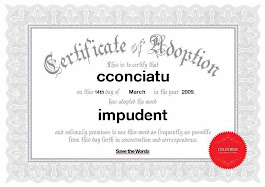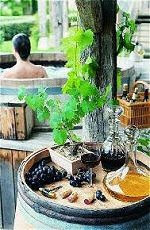Have you noticed how many commercials speak to "natural sea salt: as a delicious, nutritious - and much better than common salt - addition to their product? Campbell's Select Harvest Soup is one example.
.
What is the deal with that?
.
The claim, at times, is that their natural sea salt contains less sodium than salt. What they're probably saying is, the "sea salt" they are putting in the product is actually potassium chloride - not sodium chloride. However, if you read all of the ingredients on the can of soup - for example, the Maryland-Style Crab Soup you will see "contains less than 2% of lower sodium natural sea salt" and then you will see salt listed twice as an ingredient after that.
So they still add salt. The potassium chloride may have been added separately to the meat and/or vegetables as a normal everyday processing agent. They may have been adding it all along - for years. Then someone started thinking out of his stupid box (I hate that phrase) and came up with the bright idea of calling the potassium chloride "natural sea salt".

.
Salt is sodium chloride from the sea. Mined salt (called halite), that becomes table salt is in the ground because an old salt sea dried up bazillions of years ago. Would that not make it ....I'm going out on a limb here...sea salt??? The area was later covered by silt and dirt and whatever else covered the land over the years. Mined salt - think Morton's - is processed to remove impurities. Iodine is sometimes added and sometimes a drying agent is added to keep it from caking up.
.
"Natural sea salt" is an ambiguous and overused term for salt that has been obtained by evaporating sea water. The sea salt will be (hopefully) processed to remove impurities. Then flavoring ingredients may or may not be added, and the salt may/or may notcontain other minerals and elements that are resident in the sea.
Some "natural sea salt" is colored by minerals and elements indigenous to the area that the processors choose to leave in with the salt. Like black lava salt. It has lava in it. Nice dinner table conversation for Mister Wine Label Snob, but who wants to eat lava. Voluntarily?

Some people say they can taste the difference between table and sea salt. I suppose if they are using more than they should, or dipping radishes in it they are able to taste it. Or if things like truffles, peppercorns or cayenne are added, of course they can taste the difference.
Consistency is noticeable when you sprinkle kosher salt or unevenly grained sea salt on top of your focaccia instead of table salt or when you sprinkle popcorn salt - which is finely ground table salt on your popcorn. But once salt is added to soups, sauces or dressings it is liquefied and other ingredients are the flavoring agents. You will not be able to attribute anything but "salty" to the taste of the salt.
The thing is, we are supposed to be watching our salt intake.
.
Dietary Salt (sodium) Intake
"Normal" salt diet ... ... 1100 - 3300 mg/day
"High" salt diet ... ... 4000 - 6000 mg/day
"Low" salt diet ... ... 400 - 1000 mg/day
.
Getting back to my can of soup, it contains 480mg of sodium per serving (serving size is another incendiary subject, as many companies adjust serving size for their own benefit when reducing the volume or weight of a product rather than or in addition to raising the price or to lower the fat or sodium per serving - like saying my can of soup contains 2 servings instead of one normal human being sized serving.
.
A normal person, eating just soup for lunch or dinner may very well decide to enjoy the entire can - a bowl of soup instead of a cup of soup. In that case, you are eating 960mgs of sodium - 40% of your daily food value. If you are on a low sodium diet, you are done for the day.
So, what I ask you, is the point of highlighting the nutritious sea salt? Or any salt at all when processed foods are bringing far too much sodium into our diets?
.
The one ingredient these salts are missing - unless listed as an additive - is iodine. Iodine a necessary nutrient for a healthy thyroid, but is available in vegetables and seafood. The upside to the Select Harvest Soups is they do taste good, and the Crab soup contains only 80 calories per serving 160 calories per can. (you did know there is a give or take of 20% on the number of calories stated, didn't you?)
.

.
Quick history of iodized salt: Iodine was first added in minute amounts to salt in 1924 to prevent iodine deficiency - especially in in the Great Lakes Region and the Pacific Northwest. The deficiency was first noticed during the draft for WWI. Many men from these area suffered from goiter and were ineligible for the service. The variety of foods available today makes it easier for us to consume the amount of iodine we need without depending on iodized salt.
 Magnified Kosher Salt Crystals - this is the preferred salt for brining and curing because the uneven edges of the grouped crystals attract moisture. (75x)
Magnified Kosher Salt Crystals - this is the preferred salt for brining and curing because the uneven edges of the grouped crystals attract moisture. (75x).
*********





































.JPG)





































24 comments:
It's a culinary fad gone wild. There are differences in hand harvested salts vs.commercial preparation and it does affect flavor and texture. I love a nice Beef Rib roast baked in a kosher salt crust. You crack open the crust and discard before serving. It seals in all the delicious juices. I digress. A great read is the book, "Salt", A World History by Kurlansky.
Well, I was going to give a smart alec answer but that might be too salty. [lol]
But you're right about the salt issue. I think 'they' are just pulling our legs about sea salt being better. Follow the money trail. ♥ ∞
I am very stupid about salt. I just assumed the sea salt was worse cuz it was thicker. Okay, I'll go hide in my closet now.
All I know, besides what you just taught me, is that I need to eat less of it. Unfortunately, I am a salty person vs being a sweet person. Personality and taste wise.
I just saw on the news yesterday that salt has been proved to be a natural anti-depressant! Go figure...now we have to choose between being depressed or having low sodium!
Now I don't know what to do! Could you just prepare my meals for me and cook me healthy?
Have you read the book "Salt"? It's facinating - almost as good as the book "Cod" by the same author. The world economy was founded on salt. Salt preserved foods and made it possible to ship all over the world. The word "salary" comes from the latin for salt.
Ok - I'll stop being high faluting now. Sea Salt is just fancy-pants way of saying "plain old salt".
But what about old salt?
What a timely post! I was only on the phone an hour ago when a friend asked me to pick up a bag of 'sea salt' in town tomorrow. Truely.
Thanks for the photo of the magnified khoser salt. I'm impressed by it's uneven edges. I shall ask the nice lady at the shop tomorrow whether 'sea salt' has this property also. If she looks at me strangely (I well-know that look) I will direct her to this post.
It's great to be back and reconnect with you Cynthia!
Blessings,
Kalianne
it's all a con...makes me cross...like 'organic'...they have gone totally mad on that word now, how can water be organic??? i don't eat any salt...bah humbug is what i say....
The Kosher salt crystal looks like a zigguraut...did I misspell that?
A post worth its salt by a seasoned blogger. And peppered with interesting pictures too. You add such spice to my daily readings on the internet.
I was hoping you were going to say those salt mounds were really GIANT Hershey's Kisses. Now there's an additive I could really sink my teeth into!
Yours tah-ruly, The Salt of the Earth
umm..yeah..thanks for clearing that up for me, ROFL. Like Sparky, the Spark, I was going to have a witty remark..but nah..you might think it was to salty. ROFL..GET IT? LOLOLOLOL (yeah umm..slinking back to my corner now, lol.)
Hi! It's your "granola" daughter in sunny San Francisco...Ma, no mention of Pink Himalayan Salt, huh?
from: www.bellaonline.com/articles/art2440.asp
Alternative Medicine Site Victoria Abreo
BellaOnline's Alternative Medicine Editor
Sea Salt vs Table Salt
Table salt and sea salt have different nutritional value, which is better?
Sea Salt is a broad term that generally refers to unrefined salt derived directly from a living ocean or sea. It is harvested through channeling ocean water into large clay trays and allowing the sun and wind to evaporate it naturally. Some of the most common sources for sea salt include the Mediterranean Sea, the North Sea, and the Atlantic Ocean (particularly in France, on the coast of Brittany). Sea salt is healthier and more flavorful that traditional table salt. Available in coarse, fine and extra fine grain size.
Manufacturers of sea salt typically do not refine sea salt as much as other kinds of salt, so it still contains traces of other minerals, including iron, magnesium, calcium, potassium, manganese, zinc and iodine.
Table Salt is the most common kind of salt found in the average kitchen. It usually comes from salt mines and once mined, it is refined and most minerals are removed from it until it is pure sodium chloride. Most table salt is available either plain or iodized.
American salt manufacturers began iodizing salt in the 1920's, in cooperation with the government, after people in some parts of the country were found to be suffering from goiter, an enlargement of the thyroid gland caused by an easily-preventable iodine deficiency.
People require less than 225 micrograms of iodine a day. Seafood as well as sea salt contains iodine naturally and the supplement is unnecessary if there are sufficient quantities of either in one's diet.
Which is the better choice?
Ordinary table salt has been stripped of it's companion elements and contains additive. In studies table salts have been link to hypertension and other heart or blood illness. Table salt also gives many people the feeling of being bloating.
Natural sea salt is a healthy replacement for ordinary table salt on the market; it contains about 80 mineral elements that the body needs. Sea salt has nutrients and minerals that help your body preserve the blood cells. Overall, sea salts are better for you. If you haven't tried it, switch salts for a week and you will see a difference.
~~~~~~~~~~~~~~~~~~~~~~~~~~~~~~~~~~~~~~~~
So there.
Did you know that Pink Himalayan salt contains 84 elements found in the body? Creating a solution called solè (so-lay), which is 26% pink salt in spring water (you only use a tsp a day), balances your pH and is known to stimulate circulation, lower blood pressure and remove heavy metals from the body. I have another lovely article on Pink Salt and it's benefits and how it actually counters the iodized salt if you've over salted food. I have a book that did studies of what happens inside of your body after ingesting iodized vs. Pink Himalayan salt. And as you might have guessed, the body is taxed more with the iodized salt, a lot more. So, yeah, it's still sodium, but sea salt or even better, Pink Himalayan salt is much better for you. And yeah,I do taste the difference. I use less of it too. Iodized salt makes me feel weird and bloated. Salt is imperative in cooking, but my choice is Pink!
Sorry it's long ya'll...I'm just trying to spread healthy news around.
Love you Mom!
Jennifer the Daughter
I do not believe that I have ever come here without either learning something or laughing at something or travelling somewhere.
I love it.
Of course you have a happy home, you are in it.
Love Renee xoxoxo
I forgot to mention to Peruvian Salt specifically! Which we have some of, compliments of the granola daughter. It's pink, fine, and get's stuck in the salt shaker - maybe I'll do the Florida thing and add rice to the shaker to keep it moving.
Just spreading some bloggy love. Thanks for swinging by my blog and leaving such a nice comment.
Quite an interesting salt post!! We use Kosher Salt in most everything and I only use table salt when I bake because it's in a finer texture. Haven't tried sea salt yet.
I didn't know there was a +/- 20% on calories. That's ridiculous. What if you went shopping and there was a +/- 20% on price?
hahaha we're such a bunch of suckers aren't we. It's just like all the beauty fads I get suckered into purchasing because they contain more "cosmotol" or "look-good-i-fyers" in them. It sounds so glorious but it's all just lotion with expensive packaging and marketing.
I like my sea salt-ie things with sea chocolatie things. mmmmmm
Love the post! I don't really trust much of anything commercials say these days! 2 servings in a can of soup? Really? That's almost as bad as the pint of ice cream I was eating the other night that said it was 4 servings!
I recently read that a man is marketing Christian Salt now so that he doesn't always have to be stuck with 'Jewish' Kosher salt! Eeeeek!
Once I was reading the label on a bag of chips (back in the good old days, when I could eat them without guilt). I'd gobbled down about half the bag, and discovered a serving was 7 chips. Why was it that in those days, I was stick thin. Now I read labels, avoid salt, don't eat snacks...now I've got to watch my weight. What is UP with that?
*sigh*
Fascinating and fact filled...
I have sea salt in the cabinet but never remember to use it. I get my more than daily intake of salt from my individually wrapped packages of Cheez-its (two packs a night)...yup...
Post a Comment